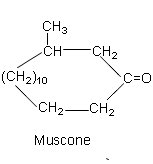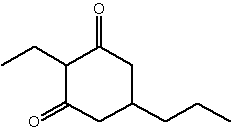
ALKYL KETONES
Ketones with various chain lengths are widely found in nature where they contribute to the flavors and odors in animals as well as in plants. Some short-chain ketones are responsible for mushroom odor, such as 3-octanone and 1-octen-3-one (Maga JA, J Agric Food Chem 1981, 29, 1). 3-Octanone is a volatile infochemical present in fungi and recognisable by fungivores (Holighaus G et al., Chemoecology 2014, 24, 57). The 2-decanone is concentrated in the oily extract of a Jamaican sponge, Plakortis sp. (Bowling JJ, et al., Chemoecology 2010, 20, 207). It strongly inhibited attachment of bacteria and mussels. This antifouling property may be used in improving this product into coating design. 2-Heptadecanone is found in the web of some spiders (Pholcidae) to attract females (Schulz S, J Chem Ecol 2013, 39, 1). Two alkyl ketones were shown to be released as pheromones by adult female spiders of the family Agnelidae : 6-methyl-3-heptanone and 8-methyl-2-nonanone (Schulz S, J Chem Ecol 2013, 39, 1).
As a first example, several 2-methyl ketones, with a 9 to 15 carbon-chain length, were identified in milk and milk products. Some of them are also present in brandies, where they are produced through b-oxidation and decarboxylation of fatty acids by yeast. One of 2-methyl ketones, 2-tridecanone, is secreted by the glandular trichomes in the tomato leaves and as an insecticide makes the plant resistant to a variety of insects.
A hydroxylated alkyl ketone, named CAI-1, 3-hydroxytridecan-4-one, was determined to be the main auto-inducer (quorum sensing substance) in Vibrio cholerae (Higgins DA et al., Nature 2007, 450, 883). At high cell density, the presence of that auto-inducer represses both the expression of virulence factors and the formation of biofilms. Thus, these findings suggest that this signaling molecule could be used as a therapy to prevent cholera infection.

3-Hydroxytridecan-4-one (CAI-1)
Several unsaturated ketones with one or two triple bonds (ketoalkenynes) have been identified in lipid extracts of Echinacea (Barnes J et al., J Pharm Pharmacol 2005, 57, 929). With some alkylamides, these compounds are at the basis of the use of these plants to treat infections, to aid wound healing and to enhance the immune system. Among these ketones, the most active has 15 carbon atoms one double and two triple bonds (pentadeca-8-ene-11,13-diyn-2-one) and was determined to be responsible for inhibitory effects on NO and PGE2 production by macrophages (Zhang X et al., Phytochemistry 2012, 74, 146). One of the acetylenic ketones extracted from E. pallida, pentadeca-8,13-dien-11-yn-2-one is the most cytotoxic when tested on human cancer cell lines (Chicca A. et al., Brit J Pharmacol 2008, 153, 879).

Pentadeca-8-ene-11,13-diyn-2-one
Other similar but less active compounds, some of them being hydroxylated, are present in lipid extracts of Echinacea.
Symmetrical ketones.
They are commonly found in epicuticular wax at the surface of many angiosperms. They have the common formula :
[CH3(CH2)n]2C=O with n = 3-20
One of the most common of these symmetrical ketones is palmitone (with n = 14).
Cyclic ketones.
These compounds are known to have sex pheromone activities in mammals, such as civetone (1-cycloheptadecen-10-one) and muscone (1-methyl-cyclopentadecan-3-one).

Furthermore, it was shown that the odor of cyclic ketones in related to the ring size.
2-Ethyl-5-propylcyclohexan-1,3-dione (chiloglottone1) is produced by orchids which employ sexual deceit to attract males of their pollinator species (Frank S et al., PNAS 2009, 106, 8877). This specific volatile signal mimics female-released sex pheromones and proved to be important in the relations between orchids of the genus Chiloglottis, native to Australia, and their pollinator species.

Chiloglottone1
In 1972, LeTellier et al. reported that a group of compounds known as 2-alkylcyclobutanones is formed from triacylglycerols on irradiation and are found in treated foods (LeTellier PR et al., Lipids 1972,7, 75). Indeed, it has been demonstrated that treatment of food products with a low dose of ionising radiation followed by suitable storage will reduce bacterial loads and increase shelf-life of the products. There is a debate on the health risks related to the consumption of irradiated foods containing.
These 2-alkylcyclobutanone compounds have the same number of carbon atoms as their precursor fatty acids and the cyclobutanones formed from palmitic, stearic, oleic and linoleic acids are 2-dodecyl-, 2-tetradecyl-, 2-tetradecenyl- and 2-tetra-decadienylcyclobutanone, respectively.

2-Alkylcyclobutanones
The evidence of the natural existence of 2-tetradecenylcyclobutanone and 2-tetradecylcyclobutanone in non-irradiated cashew nut and 2-decylcyclobutanone in nutmeg was demonstrated, thus disproving the hypothesis that these compounds are unique radiolytic products (Variyar PS et al., J Agric Food Chem 2008, 56, 11817).
A method for the detection of irradiation treatment published by the European Committee for Standardization, consists in the determination of 2-alkylcyclobutanones, but it may only be applied with complete confidence to foodstuffs treated for the purpose of microbial disinfection (doses >0.5 kGy), whose fat content is higher than 1.0 g % (Ndiaye B et al., Rad Phys Chem 1999, 55, 437).
Long-chain ketones
Formation of long-chain ketones containing from 29 to 35 carbon atoms are formed by pyrolysis of free fatty acids or triacylglycerols.
Experimentation involving heating of oleic acid and palmitic or stearic acid at temperature higher than 300°C provided evidence of the formation of mixtures of ketones with 33 or 35 carbon atoms (Evershed RP et al., Tetrahedron Lett 1995, 36, 8875).

n = 14 or 16
These compounds were studied to determine the origin of organic residues preserved in archaeological pottery but they may originate from both animal tissues or higher plant leaf waxes.
Alkenones.
These long-chain unsaturated methyl or ethyl ketones are very important compounds which are produced by a specific class of phytoplankton represented notably by the coccolithophorid Emiliana huxleyi (Volkman JK et al., Phytochemistry 1980, 19, 2619), the most abundant unicellular phytoplankton which plays a fundamental role in the total primary production in the oceans. Satellite images clearly demonstrate that point. The Emiliana blooms have a major impact on the biological carbon cycle in the ocean and on ocean/atmosphere fluxes of carbon dioxide (Westbroek et al., Global Planetary Change 1993, 8, 27).

Emiliana huxleyi
Alkenones possess several unusual characteristics, including their very long chain-length (C35-C40) and the spacing (C7) and configuration (trans) of their positions of unsaturation (Marlowe IT et al., Chem Geol 1990, 88, 349) and they were shown to be membrane-unbound lipids (Sawada K et al., Phytochemistry 2004, 65, 1299).
The two most abundant alkenones (C37:2 and C37:3) have so far unknown physiological function but their characteristic is that they remain partially intact in oceanic sediments after the cellular death and thus may be used as biomarkers.

Until now they were reported exclusively from the oceanic haptophytes Emiliana huxleyi and Gephyrocapsa oceanica and from coastal species of Chrysotila (Rontani JF et al., Phytochemistry 2004, 65, 117).
As for the phospholipid fatty acids in all living cells, the proportion of the more unsaturated alkenone is increased when the growth temperatures get colder and vice versa. Thus, a simple index ([37:2]/{[37:2]+[37:3]}) was formulated to quantify the degree of unsaturation in a given alkenone series and shown to be linear versus the growth temperature (Prahl FG et al., Nature 1987, 330, 367). Consequently, stratigraphic measurement of that index in dated sediments is done by paleoceanographers to assess climate changes on timescales ranging from interannual (El Nino) to millenial (glacial/interglacial). Thus, the variations in sea-surface of the eastern equatorial Atlantic over the past 500,000 years were inferred from the distribution of alkenones in sediments (Brassell SC et al., Nature 1986, 320, 129).
Similarly, the dissolved carbon dioxide concentration of surface waters in which E. huxleyi grew can be calculated using the proportion of the two different isotopic forms, 12C and 13C.
Thus, for their peculiarities, alkenones are not only the most abundant extractable lipids in Quaternary marine sediments but also the most precious molecules for the knowledge of past sea-surface temperature.
Devenez membre et participez au développement de la Lipidomique au XXIème siècle.
S'inscrire